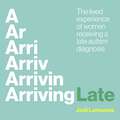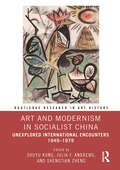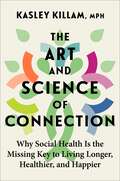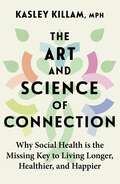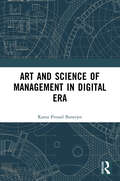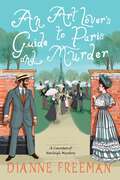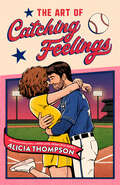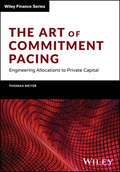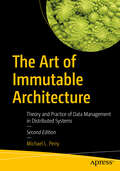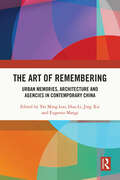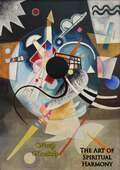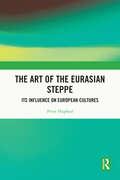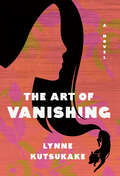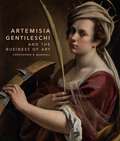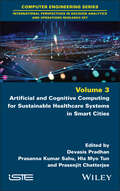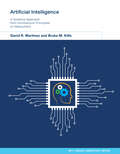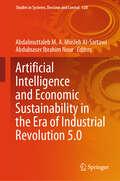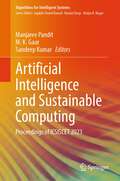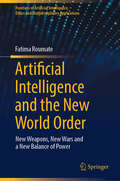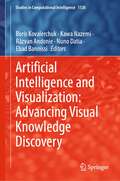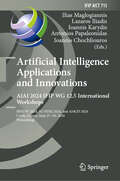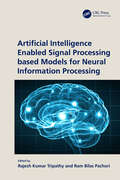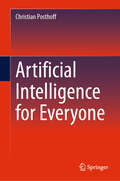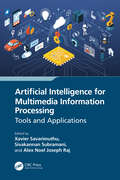- Table View
- List View
Arriving Late: The lived experience of women receiving a late autism diagnosis
by Jodi Lamanna"The stories within this book tell of the journey women take to late autism diagnosis: stories of discovery, strength, self-awareness and belonging."An honest and eye-opening collection of stories from the lives of late diagnosed autistic women across the world, brought together with thoughtful observations from neurodivergent advocate, Jodi Lamanna. Exploring life before and after diagnosis and covering topics such as masking, social interaction, parenting and employment, this book provides much-needed insight into the challenges and successes of late diagnosed women. With chances for reflection on your own experiences, informative diagnosis tips and guidance on what can be done in the future to properly support autistic women, this is an essential read for late diagnosed women and those supporting them.
Art and Modernism in Socialist China: Unexplored International Encounters 1949–1979 (Routledge Research in Art History)
by Shuyu Kong Julia F. Andrews Shengtian ZhengThis edited volume will be the first book examining the art history of China’s socialist period from the perspective of modernism, modernity, and global interactions.The majority of chapters are based on newly available archival materials and fresh critical frameworks/concepts. By shifting the frame of interpretation from socialist realism to socialist modernity, this study reveals the plurality of the historical process of developing modernity in China, the autonomy of artistic agency, and the complexity of an art world conditioned, yet not completely confined, by its surrounding political and ideological apparatus. The unexpected global exchanges examined by many of the authors in this study and the divergent approaches, topics, and genres they present add new sources and insights to this research field, revealing an art history that is heterogeneous, pluralistic, and multi-layered.The book will be of interest to scholars working in art history, art and politics, and Chinese studies.
The Art and Science of Connection: Why Social Health Is the Missing Key to Living Longer, Healthier, and Happier
by Kasley KillamA groundbreaking redefinition of what it means to be healthy that introduces the need for social health—the part of wellbeing that comes from feeling connected—to truly flourish.Exercise. Eat a balanced diet. Go to therapy. Most wellness advice is focused on achieving and maintaining good physical and mental health. But Harvard-trained social scientist and pioneering social health expert Kasley Killam reveals that this approach is missing a vital component: human connection. Relationships not only make us happier, but also are critical to our overall health and longevity. Research shows that people with a strong sense of belonging are 2.6 times more likely to report good or excellent health. Perhaps even more astonishingly, people who lack social support are up to 53% more likely to die from any cause. Yet social health has been overlooked and underappreciated—until now.Just as we exercise our physical muscles, we can strengthen our social muscles. Weaving together cutting-edge science, mindset shifts, and practical wisdom, Killam offers the first methodology for how to be socially healthy. An antidote to the loneliness epidemic and an inspiring manifesto for seeing wellbeing as not only physical and mental, but also social, The Art and Science of Connection is a handbook for thriving. In this essential book, you will:Learn a simple yet powerful framework to understand, evaluate, and bolster your social health.Discover the exact strategy or habit you need, as well as research-backed tips, to cultivate and sustain meaningful connection now and throughout your life.Glean actionable insights to develop a sense of community in your neighborhood, at work, and online from a spirited group of neighbors in Paris, the CEO of a major healthcare company, and an artificially intelligent chatbot.Get an insider look at the innovative ways that doctors, teachers, entrepreneurs, architects, government leaders, and everyday people are catalyzing a movement toward a more socially healthy society.The Art and Science of Connection will transform the way you think about each interaction with a friend, family member, coworker, or neighbor, and give you the tools you need to live a more connected and healthy life—whether you are an introvert or extrovert, if you feel stretched thin, and no matter your age or background. Along the way, Killam will reveal how a university student, a newlywed, a working professional, and a retired widow overcame challenges to thrive through connection—and how you can, too.
The Art and Science of Connection: Why Social Health is the Missing Key to Living Longer, Healthier, and Happier
by Kasley KillamA groundbreaking redefinition of what it means to be healthy that introduces the need for social health - the part of wellbeing that comes from feeling connected - to truly flourish.Exercise. Eat a balanced diet. Go to therapy. Most wellness advice is focused on achieving and maintaining good physical and mental health. But Harvard-trained social scientist and pioneering social health expert Kasley Killam reveals that this approach is missing a vital component: human connection.Relationships not only make us happier, but also are critical to our overall health and longevity. Research shows that people with a strong sense of belonging are 2.6 times more likely to report good or excellent health. Perhaps even more astonishingly, people who lack social support are up to 53% more likely to die from any cause. Yet social health has been overlooked and underappreciated - until now.Just as we exercise our physical muscles, we can strengthen our social muscles. Weaving together cutting-edge science, mindset shifts, and practical wisdom, Killam offers the first methodology for how to be socially healthy. An antidote to the loneliness epidemic and an inspiring manifesto for seeing wellbeing as not only physical and mental, but also social, The Art and Science of Connection is a handbook for thriving.In this essential book, you will:- Learn a simple yet powerful framework to understand, evaluate, and bolster your social health.- Discover the exact strategy or habit you need, as well as research-backed tips, to cultivate and sustain meaningful connection now and throughout your life.- Glean actionable insights to develop a sense of community in your neighbourhood, at work, and online from a spirited group of neighbours in Paris, the CEO of a major healthcare company, and an artificially intelligent chatbot.- Get an insider look at the innovative ways that doctors, teachers, entrepreneurs, architects, government leaders, and everyday people are catalysing a movement toward a more socially healthy society.The Art and Science of Connection will transform the way you think about each interaction with a friend, family member, coworker, or neighbour, and give you the tools you need to live a more connected and healthy life - whether you are an introvert or extrovert, if you feel stretched thin, and no matter your age or background. Along the way, Killam will reveal how a university student, a newlywed, a working professional, and a retired widow overcame challenges to thrive through connection-and how you can, too.
Art and Science of Management in Digital Era: Indian Spiritual Wisdom For Managing Sustainable Global Enterprise
by Rama Prosad BanerjeeA manager needs to perform the role of a leader, a consumer, a buyer, a maker, a worker, a messenger, an advisor and a guide to all other stakeholders in a business setting. Though the fundamentals of management are eternally same in nature, the learners and practicing managers should continuously sensitize themselves with the fundamentals in view of the changing times and circumstances. This book aims to be a guiding handbook for emerging and practicing managers in the ever-changing corporate world. Going beyond explaining just the basics of management, this book will help the readers understand the art of practicing management.
An Art Lover's Guide to Paris and Murder (A Countess of Harleigh Mystery #7)
by Dianne FreemanPerfect for fans of Miss Fisher&’s Murder Mysteries and Jane Austen alike, the latest in this delightful mystery series described as &“pure, unadulterated fun&” (Publishers Weekly) combines historical intrigue, wit, and a sophisticated Victorian setting with a charmingly independent heroine. Frances and her husband, George, have two points of interest in Paris. One is an impromptu holiday to visit the Paris Exposition. The other is personal. George&’s Aunt Julia has requested her nephew&’s help in looking into the suspicious death of renowned artist Paul Ducasse. Though Julia is not entirely forthcoming about her reasons, she is clearly a woman mourning a lost love. At the exposition, swarming with tourists, tragedy casts a pall on the festivities. A footbridge collapses. Julia is among the casualties. However, she was not just another fateful victim. Julia was stabbed to death amid the chaos. With an official investigation at a standstill, George and Frances realize that to solve the case they must dig into Julia&’s life—as well as Paul&’s—and question everything and everyone in Julia&’s coterie of artists and secrets. They have no shortage of suspects. There is Paul&’s inscrutable widow, Gabrielle. Paul&’s art dealer and manager, Lucien. Julia&’s friend Martine, a sculptress with a jealous streak. And art jurist, Monsieur Beaufoy. The investigation takes a turn when it&’s revealed that George has inherited control of Julia&’s estate—and another of her secrets. While George investigates, Frances safeguards their new legacy, and is drawn further into danger by a killer determined to keep the past buried.
The Art of Catching Feelings
by Alicia ThompsonA professional baseball player and his heckler prove that true love is worth going to bat for in the next swoony romance by USA Today bestselling author Alicia Thompson. Daphne Brink doesn&’t follow baseball, but watching &“America&’s Snoozefest&” certainly beats sitting at home in the days after she signs her divorce papers. After one too many ballpark beers, she heckles Carolina Battery player Chris Kepler, who quickly proves there might actually be a little crying in baseball. Horrified, Daphne reaches out to Chris on social media to apologize . . . but forgets to identify herself as his heckler in her message. Chris doesn&’t usually respond to random fans on social media, but he&’s grieving and fragile after an emotionally turbulent few months. When a DM from &“Duckie&” catches his eye, he impulsively messages back. Duckie is sweet, funny, and seems to understand him in a way no one else does. Daphne isn&’t sure how much longer she can keep lying to Chris, especially as she starts working with the team in real life and their feelings for each other deepen. When he finds out the truth, will it be three strikes, she&’s out?
The Art of Commitment Pacing: Engineering Allocations to Private Capital (The Wiley Finance Series)
by Thomas MeyerAdvanced guidance for institutional investors, academics, and researchers on how to manage a portfolio of private capital funds The Art of Commitment Pacing: Engineering Allocations to Private Capital provides a much-needed analysis of the issues that face investors as they incorporate closed ended-funds targeting illiquid private assets (such as private equity, private debt, infrastructure, real estate) into their portfolios. These private capital funds, once considered "alternative" and viewed as experimental, are becoming an increasingly standard component of institutional asset allocations. However, many investors still follow management approaches that remain anchored in the portfolio theory for liquid assets but that often lead to disappointing results when applied to portfolios of private capital funds where practically investors remain committed over nearly a decade. When planning for such commitments, investment managers and researchers are faced with practical questions such as: How to measure and control the real exposure to private assets? How to forecast cash-flows for commitments to private capital funds? What ranges for their returns and lifetime are realistic, and how can the investor’s skill be factored in? Over which dimensions should a portfolio be diversified and how much diversification is enough? How can the impact of co-investments or secondaries be modelled? How to design pacing plans that lead to resilient and efficient portfolios? What stress scenarios should be considered and how can they be applied? These are just examples of the many questions for which answers are provided. The Art of Commitment Pacing describes established and new methodologies for building up and controlling allocations to such investments. This book offers a systematic approach for building up and controlling allocations to such investments. The Art of Commitment Pacing is a valuable addition to the libraries of investment managers, as well as portfolio and risk managers involved in institutional investment. The book will also be of interest to advanced students of finance, researchers, and other practitioners who require a detailed understanding of forecasting and portfolio management methodologies.
The Art of Immutable Architecture: Theory and Practice of Data Management in Distributed Systems
by Michael L. PerryThis book teaches you how to evaluate a distributed system from the perspective of immutable objects. You will understand the problems in existing designs, know how to make small modifications to correct those problems, and learn to apply the principles of immutable architecture to your tools.Most software components focus on the state of objects. They store the current state of a row in a relational database. They track changes to state over time, making several basic assumptions: there is a single latest version of each object, the state of an object changes sequentially, and a system of record exists.This is a challenge when it comes to building distributed systems. Whether dealing with autonomous microservices or disconnected mobile apps, many of the problems we try to solve come down to synchronizing an ever-changing state between isolated components. Distributed systems would be a lot easier to build if objects could not change.After reading The Art of Immutable Architecture, you will come away with an understanding of the benefits of using immutable objects in your own distributed systems. You will learn a set of rules for identifying and exchanging immutable objects, and see a collection of useful theorems that emerges and ensures that the distributed systems you build are eventually consistent. Using patterns, you will find where the truth converges, see how changes are associative, rather than sequential, and come to feel comfortable understanding that there is no longer a single source of truth. Practical hands-on examples reinforce how to build software using the described patterns, techniques, and tools. By the end of the book, you will possess the language and resources needed to analyze and construct distributed systems with confidence. The assumptions of the past were sufficient for building single-user, single-computer systems. But aswe expand to multiple devices, shared experiences, and cloud computing, they work against us. It is time for a new set of assumptions. Start with immutable objects, and build better distributed systems.What You Will LearnEvaluate a distributed system from the perspective of immutable objects Recognize the problems in existing designs, and make small modifications to correct them Start a new system from scratch, applying patternsApply the principles of immutable architecture to your tools, including SQL databases, message queues, and the network protocols that you already use Discover new tools that natively apply these principles Who This Book Is ForSoftware architects and senior developers. It contains examples in SQL and languages such as JavaScript and C#. Past experience with distributed computing, data modeling, or business analysis is helpful.
The Art of Remembering: Urban Memories, Architecture and Agencies in Contemporary China
by Hua Li Jing Xie Yat Ming Loo Eugenio MangiFocusing on the non-Western context and case studies, this book explores theories of interdisciplinary architectural thinking and the construction of urban memory in Chinese cities, with an emphasis on contemporary architecture and the diversity of agencies.China has undergone one of the fastest urbanisation and urban renewal processes in human history, but discussions of urban memory in China have tended to be practice-oriented and lack theoretical reflection. This book brings together interdisciplinary architectural scholarship to interrogate the production of urban memory and examine experiences in China. The 14 chapters explore different processes, projects, materials, architecture and urban spaces in different Chinese cities by analysing cityscapes such as temples, bridges, conservation projects, architectural design, historical architecture, memorial hall, market street, city images, custom bike, food market and so on. The book deals with different agencies and methods, tangible and intangible, in the construction of memories aimed at promoting hybridised multiple identities, and explores the interplay of different versions of memory, i.e. state, public, regional, local, individual and collective memory.This book will be essential reading for scholars and students of architecture and urbanism, cultural studies and China studies, as well as architects, urban planners and historians interested in these fields.
The Art of Spiritual Harmony
by Wassily Kandinsky"The Art of Spiritual Harmony" is a seminal work by the pioneering abstract artist Wassily Kandinsky. This influential book delves into the profound connection between art and spirituality, presenting Kandinsky's revolutionary ideas on the role of art in expressing the innermost emotions and transcending the material world.Kandinsky, a master of color and form, articulates his belief that art should go beyond mere representation and tap into deeper spiritual truths. He explores the concept of "inner necessity," the driving force that compels true artists to create works that resonate on a spiritual level. Through a series of essays and reflections, Kandinsky discusses the transformative power of color, the significance of abstract forms, and the artist's role in society.Rich with philosophical insights and artistic theory, "The Art of Spiritual Harmony" offers readers a glimpse into Kandinsky's visionary mind. The book is adorned with illustrations of his groundbreaking paintings, showcasing his journey from figurative art to pure abstraction. Kandinsky's writings inspire artists and art lovers to seek harmony between the spiritual and the aesthetic, encouraging them to view art as a means of personal and collective enlightenment.This timeless work remains a cornerstone of modern art theory, providing invaluable guidance for anyone interested in the spiritual dimensions of artistic expression. "Kandinsky - The Art of Spiritual Harmony" is a must-read for artists, scholars, and anyone seeking to understand the profound relationship between art and the human spirit.
The Art of the Eurasian Steppe: Its Influence on European Cultures
by Peter HupfaufThe Art of the Eurasian Steppe is a contextual analysis which traces the stylistic transformation of artefacts depicting animals from various cultures of the Eurasian steppe, and investigates its possible influence on Central and Northern European art. A wide range of individual cultures are "visited" and their historic, cultural, and geographic specifics are explored. The survey in this book is based on a chronological structure, including an East-West geographic direction. This accommodates to position described artefacts of certain styles within time periods, cultures, and locations.Most of the existing literature related to cultures of the Eurasian steppe is specialised on one particular culture or one archaeological excavation. The book is written as a hypothetical journey through time and space, structured in an east to west direction. It provides a wide-reaching overview by placing the discussed artefacts into a cultural, geographic, and chronologic frame, particularly the thousand years between 500 BC and 500 AD. Artistic expression and style are a central theme to explore possible relationships between civilisations of the Eurasian steppe and their influence on medieval Central and Northern European creation of artefacts.Academics in the fields of art history, archaeology, history, and fine arts will find this book compelling/useful.
The Art of Vanishing: A novel
by Lynne Kutsukake"A fascinating glimpse into the intersection of art, class, and the complexity of adult friendship. . . . I couldn&’t put this book down.&” —Waubgeshig Rice, author of Moon of the Turning LeavesAn intimate, explosive story of creativity and friendship between two young Japanese women in 1970s Tokyo.Akemi&’s desire for independence and aversion to marriage are unusual in her small village. A gift for drawing allows her to move to a rooming house in Tokyo where she studies medical illustration, finding satisfaction in the precision and purpose of her work. Sayako is the first roommate to pay Akemi attention, and they quickly become inseparable—Sayako drawn to Akemi&’s humble origins, so distinct from her own insufferable, wealthy family; Akemi attracted to Sayako&’s rebelliousness and her aspiration to be a painter. As Akemi begins to model for Sayako, their connection deepens. Together, they attend &‘happenings,' encounters arranged by two enigmatic artists, Nezu and Kaori, in random locations, intended to free them from their worldly attachments. Following a devastating betrayal, Sayako disappears, and Akemi becomes determined to find her—and in the process, must newly face herself. Tender, enthralling, and evocative of the energy of Japan in the 1970s, The Art of Vanishing is the story of a young woman struggling to see and be seen; of authenticity and art; of the thin line between loyalty and obsession.
Artemisia Gentileschi and the Business of Art
by Christopher R. MarshallA new account of the renowned Baroque painter, revealing how her astute professional decisions shaped her career, style, and legacyArt has long been viewed as a calling—a quasi-religious vocation that drives artists to seek answers to humanity&’s deepest questions. Yet the art world is a risky, competitive business that requires artists to make strategic decisions, especially if the artist is a woman. In Artemisia Gentileschi and the Business of Art, Christopher Marshall presents a new account of the life, work, and legacy of the Italian Baroque painter, revealing how she built a successful four-decade career in a male-dominated field—and how her business acumen has even influenced the resurrection of her reputation today, when she has been transformed from a footnote of art history to a globally famous artist and feminist icon.Combining the most recent research with detailed analyses of newly attributed paintings, the book highlights the business considerations behind Gentileschi&’s development of a trademark style as she marketed herself to the public across a range of Italian artistic centers. The disguised self-portraits in her early Florentine paintings are reevaluated as an effort to make a celebrity brand of her own image. And, challenging the common perception that Gentileschi&’s only masterpieces are her early Caravaggesque paintings, the book emphasizes the importance of her neglected late Neapolitan works, which are reinterpreted as innovative responses to the conventional practices of Baroque workshops.Artemisia Gentileschi and the Business of Art shows that Gentileschi&’s remarkable success as a painter was due not only to her enormous talent but also to her ability to respond creatively to the continuously evolving trends and challenges of the Italian Baroque art world.
Artificial and Cognitive Computing for Sustainable Healthcare Systems in Smart Cities
by Prasenjit Chatterjee Devasis Pradhan Prasanna Kumar Sahu Hla Myo TunArtificial and Cognitive Computing for Sustainable Healthcare Systems in Smart Cities delves into the transformative potential of artificial and cognitive computing in the realm of healthcare systems, maintaining a specific emphasis on sustainability. By exploring the integration of advanced technologies in smart cities, the authors examine and discuss how AI and cognitive computing can be harnessed to enhance healthcare delivery. The book provides focused navigation through innovative solutions and strategies that contribute to the creation of sustainable healthcare ecosystems within the dynamic environment of smart cities. From optimizing resource utilization to improving patient outcomes, this comprehensive exploration provides insight for readers with an interest in the future of healthcare within the era of intelligent urban development.
Artificial Intelligence: A Systems Approach from Architecture Principles to Deployment (MIT Lincoln Laboratory Series)
by David R. Martinez Bruke M. KifleThe first text to take a systems engineering approach to artificial intelligence (AI), from architecture principles to the development and deployment of AI capabilities.Most books on artificial intelligence (AI) focus on a single functional building block, such as machine learning or human-machine teaming. Artificial Intelligence takes a more holistic approach, addressing AI from the view of systems engineering. The book centers on the people-process-technology triad that is critical to successful development of AI products and services. Development starts with an AI design, based on the AI system architecture, and culminates with successful deployment of the AI capabilities. Directed toward AI developers and operational users, this accessibly written volume of the MIT Lincoln Laboratory Series can also serve as a text for undergraduate seniors and graduate-level students and as a reference book. Key features:In-depth look at modern computing technologies Systems engineering description and means to successfully undertake an AI product or service development through deploymentExisting methods for applying machine learning operations (MLOps)AI system architecture including a description of each of the AI pipeline building blocksChallenges and approaches to attend to responsible AI in practice Tools to develop a strategic roadmap and techniques to foster an innovative team environment Multiple use cases that stem from the authors&’ MIT classes, as well as from AI practitioners, AI project managers, early-career AI team leaders, technical executives, and entrepreneurs Exercises and Jupyter notebook examples
Artificial Intelligence and Economic Sustainability in the Era of Industrial Revolution 5.0 (Studies in Systems, Decision and Control #528)
by Abdalmuttaleb M. A. Musleh Al-Sartawi Abdulnaser Ibrahim NourIndustry 5.0 has been dubbed as the digital revolution with a soul. This book incorporates a wealth of research which integrates artificial intelligence (AI) with economic sustainability and Industry 5.0. It examines the human-centricity of the upcoming digital revolution and the role of sustainable technologies in enhancing the livelihoods of workers, individuals, communities, and eventually societies. It provides insight on important areas related to artificial intelligence, sustainable development, and society 5.0. The chapters present a wide range of topics including block cipher, entrepreneurship and AI, AI and stock trading decisions, digital transformation, knowledge management, chatbot engineering, cybersecurity, and smart metering system. This book is beneficial to scholars and academics who will find in it the knowledge of the support of AI and its contribution to economic sustainability, and solutions to enhance human-centricity and resilience.
Artificial Intelligence and Machine Learning in Drug Design and Development (Fintech in a Sustainable Digital Society)
by Manoj Kumar Anand Nayyar Abhirup Khanna May El Barachi Sapna JainThe book is a comprehensive guide that explores the use of artificial intelligence and machine learning in drug discovery and development covering a range of topics, including the use of molecular modeling, docking, identifying targets, selecting compounds, and optimizing drugs. The intersection of Artificial Intelligence (AI) and Machine Learning (ML) within the field of drug design and development represents a pivotal moment in the history of healthcare and pharmaceuticals. The remarkable synergy between cutting-edge technology and the life sciences has ushered in a new era of possibilities, offering unprecedented opportunities, formidable challenges, and a tantalizing glimpse into the future of medicine. AI can be applied to all the key areas of the pharmaceutical industry, such as drug discovery and development, drug repurposing, and improving productivity within a short period. Contemporary methods have shown promising results in facilitating the discovery of drugs to target different diseases. Moreover, AI helps in predicting the efficacy and safety of molecules and gives researchers a much broader chemical pallet for the selection of the best molecules for drug testing and delivery. In this context, drug repurposing is another important topic where AI can have a substantial impact. With the vast amount of clinical and pharmaceutical data available to date, AI algorithms find suitable drugs that can be repurposed for alternative use in medicine. This book is a comprehensive exploration of this dynamic and rapidly evolving field. In an era where precision and efficiency are paramount in drug discovery, AI and ML have emerged as transformative tools, reshaping the way we identify, design, and develop pharmaceuticals. This book is a testament to the profound impact these technologies have had and will continue to have on the pharmaceutical industry, healthcare, and ultimately, patient well-being. The editors of this volume have assembled a distinguished group of experts, researchers, and thought leaders from both the AI, ML, and pharmaceutical domains. Their collective knowledge and insights illuminate the multifaceted landscape of AI and ML in drug design and development, offering a roadmap for navigating its complexities and harnessing its potential. In each section, readers will find a rich tapestry of knowledge, case studies, and expert opinions, providing a 360-degree view of AI and ML’s role in drug design and development. Whether you are a researcher, scientist, industry professional, policymaker, or simply curious about the future of medicine, this book offers 19 state-of-the-art chapters providing valuable insights and a compass to navigate the exciting journey ahead. Audience The book is a valuable resource for a wide range of professionals in the pharmaceutical and allied industries including researchers, scientists, engineers, and laboratory workers in the field of drug discovery and development, who want to learn about the latest techniques in machine learning and AI, as well as information technology professionals who are interested in the application of machine learning and artificial intelligence in drug development.
Artificial Intelligence and Sustainable Computing: Proceedings of ICSISCET 2023 (Algorithms for Intelligent Systems)
by Sandeep Kumar Manjaree Pandit M. K. GaurThis book presents high-quality research papers presented at the 5th International Conference on Sustainable and Innovative Solutions for Current Challenges in Engineering and Technology (ICSISCET 2023) held at Madhav Institute of Technology & Science (MITS), Gwalior, India, during October 21–22, 2023. The book extensively covers recent research in artificial intelligence (AI) that knit together nature-inspired algorithms, evolutionary computing, fuzzy systems, computational intelligence, machine learning, deep learning, etc., which is very useful while dealing with real problems due to their model-free structure, learning ability, and flexible approach. These techniques mimic human thinking and decision-making abilities to produce systems that are intelligent, efficient, cost-effective, and fast. The book provides a friendly and informative treatment of the topics which makes this book an ideal reference for both beginners and experienced researchers.
Artificial Intelligence and the New World Order: New weapons, New Wars and a New Balance of Power (Frontiers of Artificial Intelligence, Ethics and Multidisciplinary Applications)
by Fatima RoumateThis book discusses the implications of artificial intelligence (AI) on post-COVID-19 international relations. With the decline and fall of U.S. global leadership and the emergence of new powerful actors, as hastened by the global pandemic, new arms are now used in new forms of wars with new players. The balance of power swings between geostrategic interests and those linked to the global governance of virtual space and the race to technological sovereignty. Chapters focus on the challenges imposed by these changes on different parts of the international system—law, governance, diplomacy, international psychological security—and articulate new strategies and ethical policies as possible solutions. The volume is interdisciplinary and will appeal to researchers, students, and professionals across fields interested in the ethics of AI in the international system.
Artificial Intelligence and Visualization: Advancing Visual Knowledge Discovery (Studies in Computational Intelligence #1126)
by Kawa Nazemi Boris Kovalerchuk Răzvan Andonie Nuno Datia Ebad BannissiThis book continues a series of Springer publications devoted to the emerging field of Integrated Artificial Intelligence and Machine Learning with Visual Knowledge Discovery and Visual Analytics that combine advances in both fields. Artificial Intelligence and Machine Learning face long-standing challenges of explainability and interpretability that underpin trust. Such attributes are fundamental to both decision-making and knowledge discovery. Models are approximations and, at best, interpretations of reality that are transposed to algorithmic form. A visual explanation paradigm is critically important to address such challenges, as current studies demonstrate in salience analysis in deep learning for images and texts. Visualization means are generally effective for discovering and explaining high-dimensional patterns in all high-dimensional data, while preserving data properties and relations in visualizations is challenging. Recent developments, such as in General Line Coordinates, open new opportunities to address such challenges.This book contains extended papers presented in 2021 and 2022 at the International Conference on Information Visualization (IV) on AI and Visual Analytics, with 18 chapters from international collaborators. The book builds on the previous volume, published in 2022 in the Studies in Computational Intelligence. The current book focuses on the following themes: knowledge discovery with lossless visualizations, AI/ML through visual knowledge discovery with visual analytics case studies application, and visual knowledge discovery in text mining and natural language processing. The intended audience for this collection includes but is not limited to developers of emerging AI/machine learning and visualization applications, scientists, practitioners, and research students. It has multiple examples of the current integration of AI/machine learning and visualization for visual knowledge discovery, visual analytics, and text and natural language processing. The book provides case examples for future directions in this domain. New researchers find inspiration to join the profession of the field of AI/machine learning through a visualization lens.
Artificial Intelligence Applications and Innovations. AIAI 2024 IFIP WG 12.5 International Workshops: MHDW 2024, 5G-PINE 2024, and ΑΙ4GD 2024, Corfu, Greece, June 27-30, 2024, Proceedings (IFIP Advances in Information and Communication Technology #715)
by Ioannis Karydis Lazaros Iliadis Ilias Maglogiannis Antonios Papaleonidas Ioannis ChochliourosThis book constitutes the refereed proceedings of three International Workshops held as parallel events of the IFIP WG 12.5 International Workshops on Artificial Intelligence Applications and Innovations, AIAI 2024, held in Corfu, Greece, during June 27-30, 2024. The 30 full papers and 4 short papers presented in this book were carefully reviewed and selected from 69 submissions. AIAI 2024 Workshop volume presents papers from the following three workshops: 13th event of the International Mining Humanistic Data Workshop (MHDW 2024) 9th 5G-PINE Workshop (5G-PINE 2024) 1st Workshop on AI Applications for Achieving the Green Deal Targets (ΑΙ4GD 2024).
Artificial Intelligence Enabled Signal Processing based Models for Neural Information Processing
by Ram Bilas Pachori Rajesh Kumar TripathyThe book provides details regarding the application of various signal processing and artificial intelligence-based methods for electroencephalography data analysis. It will help readers in understanding the use of electroencephalography signals for different neural information processing and cognitive neuroscience applications. The book: Covers topics related to the application of signal processing and machine learning-based techniques for the analysis and classification of electroencephalography signals Presents automated methods for detection of neurological disorders and other applications such as cognitive task recognition, and brain-computer interface Highlights the latest machine learning and deep learning methods for neural signal processing Discusses mathematical details for the signal processing and machine learning algorithms applied for electroencephalography data analysis Showcases the detection of dementia from electroencephalography signals using signal processing and machine learning-based techniques It is primarily written for senior undergraduates, graduate students, and researchers in the fields of electrical engineering, electronics and communications engineering, and biomedical engineering.
Artificial Intelligence for Everyone
by Christian PosthoffThis book demystifies the topic of Artificial Intelligence for readers of varying backgrounds. The content should enable many people to discuss and follow ongoing developments in an informed way, to draw conclusions for their own life and workplace and to acquire the necessary new knowledge. The book strives to provide basic knowledge that will objectify the discussions and relieve some of the creepiness of utopian films. It must also be understood that research results are a necessary condition for progress; they are not sufficient until they can be translated into practice embedded in programs. This difficult relationship between theory and practice has been known for a long time.
Artificial Intelligence for Multimedia Information Processing: Tools and Applications
by Xavier Savarimuthu Sivakannan Subramani Alex Noel Joseph RajAdvances in artificial intelligence (AI), widespread mobile devices, internet technologies, multimedia data sources, and information processing have led to the emergence of multimedia processing. Multimedia processing is the application of signal processing tools to multimedia data—text, audio, images, and video—to allow the interpretation of these data, particularly in urban and smart city environments. This book discusses the new standards of multimedia and information processing from several technological perspectives, including analytics empowered by AI, streaming on the intelligent edge, multimedia edge caching and AI, services for edge AI, and hardware and devices for multimedia on edge intelligence.FEATURES Covers a wide spectrum of enabling technologies for AI and machine learning for multimedia and information processing Includes many applications using AI, from robotics and driverless cars to environmental, human health, and remote sensing Presents an overview of the fundamentals of AI and multimedia processing: imaging, signal, and speech Explains new models and architectures for multimedia streaming, services, and caching for AI Discusses the emerging paradigms of the deployment of hardware and devices for multimedia on edge intelligence Gives recommendations for future research in multimedia and AI This book is written for engineers and graduate students in image and signal processing, information processing, environmental engineering, medical and public health, etc., who are interested in machine learning, deep learning, and multimedia processing.
